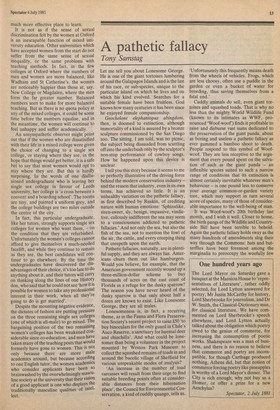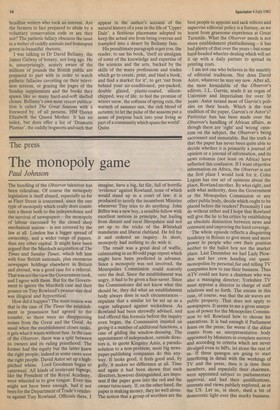A pathetic fallacy
Tony Samstag
Let me tell you about Lonesome George. He is one of the giant tortoises lumbering around the Galapagos Islands and is the last of his race, or sub-species, unique to the particular island on which he lives and on which his kind evolved. Searches for a suitable female have been fruitless. God knows how many centuries it has been since he enjoyed female companionship.
Geochelone elephantopus abingdoni, then, is doomed to extinction, although immortality of a kind is assured by a bronze sculpture commissioned by the San Diego zoo. The sitting, I am told, was no picnic, the subject being dissuaded from scuttling off into the underbush only by the sculptor's non-stop performance of cowboy songs. How he happened upon this device is unclear.
I tell you this story because it seems to me so perfectly illustrative of the driving force behind the modern conservation industry — and the reason that industry, even in its own terms, has achieved so little. It is an unhealthy variation on the pathetic fallacy, as first described by Ruskin, of crediting nature with human emotions: `Sphinxlike, siren-sweet, sly, benign, impassive, vindictive, callously indifferent the sea may seem to a consciousness addicted to pathetic fallacies.' And not only the sea, but also the fish of the sea, not to mention the fowl of the air, the cattle, and every creeping thing that creepeth upon the earth.
Pathetic fallacies, naturally, are in plentiful supply, and they are always fun. Americans churn them out like hamburgers. Would you believe, for example, that the American government recently wound up a three-million-dollar scheme to buy thousands of acres on the east coast of Florida as a refuge for the dusky sparrow? The reason you have never heard of the dusky sparrow is that only about half a dozen are known to exist. Like Lonesome George, they are all males.
Lonesomeness is, in fact, a recurring theme, as in the Fauna and Flora Preservation Society's recent project to raise £50 'to buy binoculars for the only guard in Chile's Auco Reserve, a sanctuary for huemal deer and chinchilla'. And what could be lonesomer than being a volunteer in the project mounted by Weston Park Museum to collect the squashed remains of toads in and around the bucolic village of Sheffield for various unspeakable modes of analysis?
'An increase in the number of toad carcasses will result from their urge to find suitable breeding points often at considerable distances from their hibernation place', the Council for Environmental Conservation, a kind of cuddly quango, tells us. 'Unfortunately this frequently means death from the wheels of vehicles. Frogs, which are less choosy, often use a puddle in the garden or even a bucket of water for breeding, thus saving themselves from a fatal end.'
Cuddly animals do sell, even giant tortoises and squashed toads. That is why no less than the mighty World Wildlife Fund (known to its intimates as VVWF, pronounced Woof-woof ) finds it profitable to raise and disburse vast sums dedicated to the preservation of the giant panda, about as boring and useless a pathetic fallacy as ever gummed a bamboo shoot to death. People respond to this symbol of Woofwoof. They are less receptive to the argument that every pound spent on the salvation of such as the giant panda — an inflexible species suited to such a narrow range of conditions that its extinction is almost certainly inevitable whatever man's behaviour — is one pound less to conserve your average common-or-garden variety tree, which may support in turn several score of species, many of those of considerable importance to the well-being of man.
It was Woof-woofs 20th birthday last month, and I wish it well. Closer to home, the birth pangs of the Wildlife and Countryside Bill have been terrible to behold. Again the pathetic fallacy holds sway as the many hundreds of amendments slog their way through the Commons: bats and butterflies have been foremost among the marginalia to preoccupy the woefully few headline writers who took an interest. Are the farmers in fact prepared to abide by a voluntary conservation code or are they not? The pathetic fallacy obscures the issue in a welter of cuddly animals and homespun green-is-beautiful rhetoric.
I was talking to Dr David Bellamy, the James Galway of botany, not long ago. He is, unsurprisingly, acutely aware of the millions of pounds the British public are prepared to part with in order to watch pathetic fallacies cavorting on their television screens, or gracing the pages of the Sunday supplements and the books they spawn like so many hard-and-soft shelled clones. Bellamy's own most recent publication is called The Great Seasons with a foreword by, of all persons, HM Queen Elizabeth the Queen Mother. It has no index, but does offer a list of 'Dramatis Plantae', the cuddly bogworts and such that appear in the author's account of the natural history of a year in the life of 'Upper Dale', a fictitious placename adopted to keep the actual site from being overrun and trampled into a desert by Bellamy fans.
His penultimate paragraph urges you, the reader, to use his book, 'itself an amalgam of some of the knowledge and expertise of the sciences and the arts, backed by the skills of the many professions and trades which go to create, print, and bind a book, and find a market for it', to get 'out from behind your air-conditioned, pre-packed, double glazed, plastic-coated, siliconchipped, way of life, to feel the promise of winter snow, the softness of spring rain, the warmth of summer sun, the rich blend of autumn; to let the pulse of the seasons put a sense of purpose back into your living as part of a community which spans the world'. Quite.







































 Previous page
Previous page